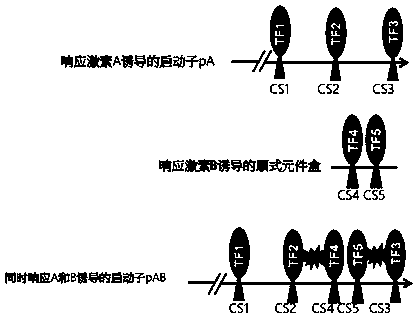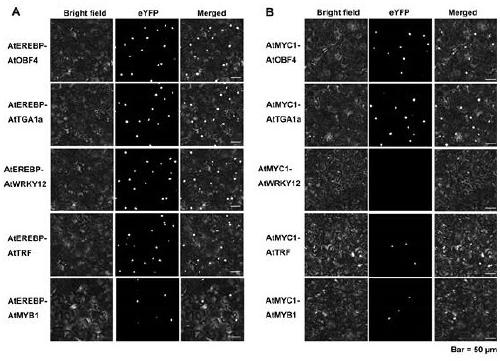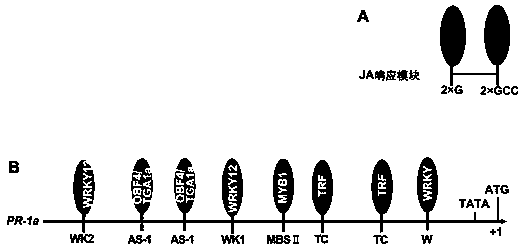Method for constructing double-hormone response promoter on basis of interaction relationship between transcription factors
A technology of transcription factors and promoters, applied in genetic engineering, botanical equipment and methods, biochemical equipment and methods, etc., can solve the problem of unable to meet the requirements of pathogen-induced promoters, single signal, unable to change the mutual antagonism between hormones, etc. problem, to achieve the effect of changing the pathogenic induction characteristics, high activity and fast response
- Summary
- Abstract
- Description
- Claims
- Application Information
AI Technical Summary
Problems solved by technology
Method used
Image
Examples
Embodiment 1
[0044] Utilize pattern chart to further analyze the core content of the present invention
[0045] A method for constructing dual hormone-responsive promoters based on the interaction between transcription factors, such as figure 1 shown, including the following steps:
[0046] 1) Select a natural promoter pA as the basic backbone, which includes multiple cis-acting elements CS1, CS2, and CS3 induced in response to hormone A; selection includes cis-acting elements CS4 and CS4 induced in response to hormone B CS5 assembles into response element cassettes; the hormone A is not the same as the hormone B.
[0047] 2) According to the literature or database, find that the transcription factors bound by CS1, CS2, CS3, CS4 and CS5 are TF1, TF2, TF3, TF4 and TF5 respectively.
[0048] 3) Using Bimolecular Fluorescent Complementation (BiFC) and other technologies, respectively detect whether there is an interaction between transcription factors TF4 and TF5 and transcription factors ...
Embodiment 2
[0052] Interaction analysis between transcription factors
[0053] 2.1 Extraction of RNA from Arabidopsis plants
[0054] Use a scalpel to injure the roots of Colombian wild-type Arabidopsis plants, and then use the root irrigation inoculation method to water for 10 8 spores / mL of Verticillium dahliae V991 spore suspension, 20mL per plant, inoculated with Verticillium dahliae for 24 hours, using the leaves of Arabidopsis plants as materials, using the plant RNA rapid extraction kit (Aidlab), and operating the process according to the instructions Extraction of RNA from Arabidopsis plants. Then, using RNA as a template, a strand of cDNA was synthesized using TaKaRa's reverse transcription kit according to the operating instructions, and the coding sequence used for the synthesis of transcription factors was stored at -20°C.
[0055] 2.2 Acquisition of transcription factor coding sequences
[0056] PR-1a activation using the Plant Promoter Database via http: / / www.dna.affrc.go...
Embodiment 3
[0062] Example 3 Construction of pathogen-inducible promoter
[0063] 3.1 Construction of response component box
[0064] Typical cis-acting elements that respond to JA induction mainly include G-box and GCC-box. Combining cis-acting elements in the form of double copies, and there needs to be a certain distance between different cis-acting elements, so that the strength of the promoter can be improved without excessive expansion such as high background activity negative impact. To increase the strength of the JA-induced response, GCC-box and G-box were combined in double copies, respectively. due to tobacco NTPMT The G-box element in the promoter and the intermediate junction pair of the GCC motif NTPMT The induction of the promoter response to JA plays an important role, therefore, the JA response module is designed as follows: with a segment from tobacco NTPMT The middle junction sequence of the promoter G-box element and the GCC motif connects two doubled JA response...
PUM
 Login to View More
Login to View More Abstract
Description
Claims
Application Information
 Login to View More
Login to View More - Generate Ideas
- Intellectual Property
- Life Sciences
- Materials
- Tech Scout
- Unparalleled Data Quality
- Higher Quality Content
- 60% Fewer Hallucinations
Browse by: Latest US Patents, China's latest patents, Technical Efficacy Thesaurus, Application Domain, Technology Topic, Popular Technical Reports.
© 2025 PatSnap. All rights reserved.Legal|Privacy policy|Modern Slavery Act Transparency Statement|Sitemap|About US| Contact US: help@patsnap.com



